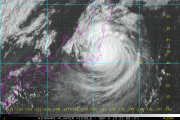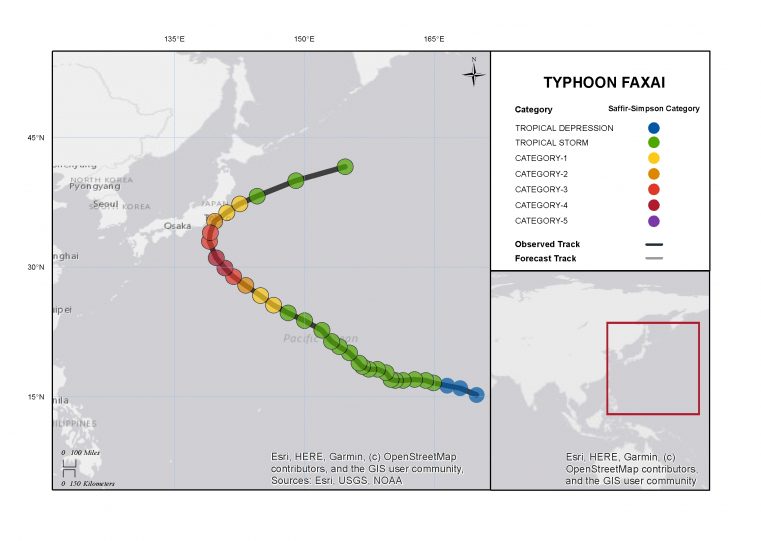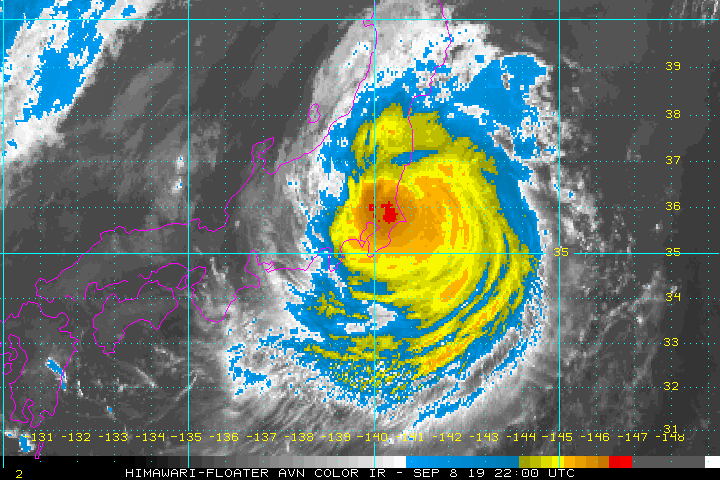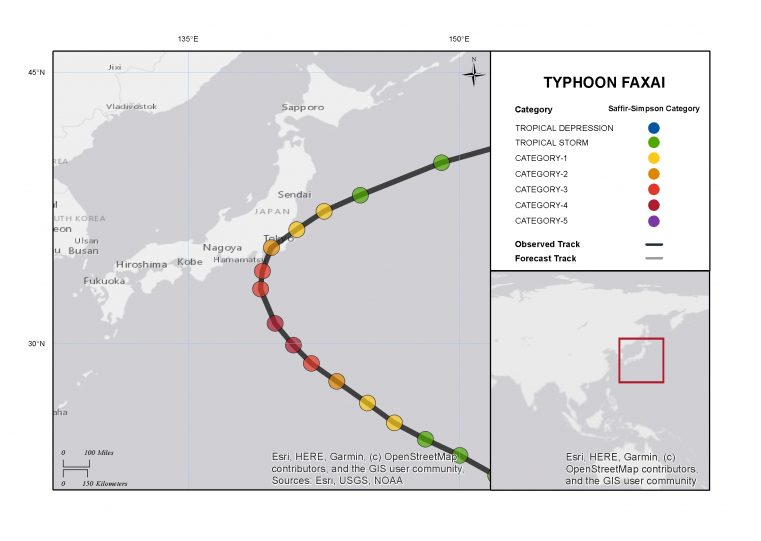

In the Northwest Pacific Basin, Typhoon Faxai made landfall on September 9, 2019, around 5 AM local time near the city of Chiba in the Greater Tokyo Area, after crossing the Tokyo Bay as a category-2. Among the strongest typhoons to hit the Greater Tokyo Area in recorded history, Faxai was accompanied by record wind gusts from multiple weather stations in the affected region. Damaging winds caused severe power outages, with over 900,000 households left without power. Faxai also disrupted the Tokyo transport system. Flights, trains and ferries to and from the metropolitan area were suspended, and major highways were closed. Authorities issued non-compulsory evacuation warnings to over 390,000 people, and about 5,000 people in Chiba and Kanagawa prefectures were ordered to evacuate. According to media reports at least three were killed and over 40 were injured. It will take time to assess the full scope and severity of the event including focused loss estimates, and our first thoughts and concerns are with those directly affected.

Typhoon Faxai Track and Position Reports. Source: JTWC.
Physical Discussion
Typhoon Faxai originated on August 29 as a feature east of the International Date Line, and the Joint Typhoon Warning Center (JTWC) initiated advisories for the tropical depression at 18 UTC September 1. On September 2 at 12 UTC the system was upgraded by the JTWC to a tropical storm, as the fourteenth named storm of the current season for the Northwest Pacific Basin, while located over 4,500 kilometers (2,700 miles) east of Okinawa. After initially struggling to intensify, it gradually strengthened while moving on a west-northwest course towards Japan. On September 6 at 18 UTC the storm was upgraded by the JTWC to typhoon status, equivalent to a category-1 on the Saffir-Simpson scale.
The system continued to track west-northwest towards Honshū, while further intensifying by drawing energy from above-average sea-surface temperatures. Faxai reached its peak intensity at 18 UTC September 7, with 1-minute sustained winds of around 210 km/hr (130 mph), a category-4 on the Saffir-Simpson Scale. Over the next twelve hours, Faxai weakened to a category-3 while making a turn to the north towards Honshu. While on final approach to Honshu, Faxai carried 1-minute sustained winds of around 185 km/hr (115 mph), a category-3 on the Saffir Simpson Scale. The storm then made a gradual turn to the northeast to approach the Tokyo area.
By 18 UTC September 8 the center of circulation was located near Yokosuka, between Sagami Bay and Tokyo Bay, with 1-minute sustained winds of around 170 km/hr (105 mph), a category-2 on the Saffir-Simpson Scale. A central pressure of 955 mb was also reported at the time. According to media reports, the center of circulation then crossed Tokyo Bay to make final landfall near the city of Chiba, east of Tokyo, shortly before 5 AM local time Monday (20 UTC Sunday). Faxai is among the strongest typhoons to affect Tokyo in recorded history since the middle part of the century.

Satellite image of Faxai (Infrared) near the time of landfall (22 UTC September 8). Source: NOAA/NESDIS.
According to the Japan Meteorological Agency, several weather stations in the Tokyo region identified record peak wind gusts: 207 km/h (128 mph) in Chiba, 156 km/h (97 mph) at Tokyo Haneda Airport, and 165 km/h (106 mph) at Tokyo Narita Airport. Record wind gusts were also recorded in the Izu Islands and in municipalities in the Shizuoka Prefecture. After making landfall the typhoon continued to track northeast and continued to lose strength.
Faxai also brought heavy rainfall. Cumulative precipitation in the city of Izu in the Shizuoka Prefecture reached 440 millimeters (17.6 inches), with 109 millimeters (4.36 inches) falling in only one hour soon after landfall. By 00 UTC September 9 (9 AM local time) Faxai had moved offshore into the northern Pacific Ocean and had weakened to a category-1 due to land and topography interaction. After further weakening, the system was reclassified by the JTWC as a tropical storm while following a northeasterly track away from Japan.

Typhoon Faxai Track and Position Reports. Source: JTWC.
Impacts
According to media reports Faxai left three people dead and over 40 injured. Before the typhoon made landfall the Japan Meteorological Agency issued warnings for floods, landslides, and storm surge. Evacuation advisories issued by authorities affected a total of 390,000 people in the Kanagawa, Shizuoka, and Tokyo Prefectures, and over 5,000 people were ordered to leave their homes.
Major train operators including Japanese Railways East and Toei Subway suspended their service in the morning of the day of the landfall, stranding millions of commuters. Other local lines in the Greater Tokyo Area were also affected, including trains connecting Tokyo and Yokohama to the Narita International Airport and the Haneda International Airport. Central Japan Railway Co. suspended more than 100 Shinkansen bullet trains between Tokyo and Osaka. In the meantime several major highways were obstructed by downed trees and other debris. Airlines cancelled over 160 flights to and from Tokyo, including 49 operated by Japan Airlines and 41 by Nippon Airways. Over 17,000 passengers were stranded at Narita International Airport.
The strong winds toppled two large power transmission towers near Chiba, and power outages were widespread in the Greater Tokyo Area. According to Tokyo Electric Power Co., the electric utility servicing the Kantō region, over 934,000 households were left without power in the worst blackout in the area since the 2011 Tōhoku earthquake. In a statement, the Tokyo Disaster Prevention Department informed that the Shikinejima and Oshima islands were left entirely without electricity. Power outages caused commercial and industrial activities to suspend operations, including Tokyo Disneyland and a Sony production plant in Kisarazu, Chiba Prefecture. Cosmo Energy Holdings Co. also interrupted operations at two crude oil distillation units in its refinery in Chiba. Meanwhile a floating solar power plant offshore from Tokyo was damaged as some panels caught fire. The Japan Atomic Energy Agency also said in a statement that its research reactor in Oarai in the Ibaraki Prefecture, which had not been in operation since 2006, was damaged. One of the cooling towers of the reactor had collapsed due to the strong winds, but no radioactive material was leaked. Seven nuclear monitoring posts in the Chiba Prefecture failed to send radiation data soon after the typhoon made landfall, but alternative monitoring posts did not detect any anomaly in radiation levels.
Many vessels were adrift in the Tokyo Bay due to the storm. According to the Japan Coast Guard, strong winds and high waves caused a crane carrier to collide with a pier in Yokosuka Port, Kanagawa Prefecture. Meanwhile a floating dock also came into contact with the Yokohama Bay Bridge in the Kanagawa Prefecture. Three other collisions involving cargo ships and ferries were also reported.
Heavy rains were responsible for some minor landslides, and flooding caused two Nissan plants west of Tokyo, including the Oppama factory, to suspend operations. Mobile services offered by NTT Docomo Inc. were disrupted in several areas of the Kantō region. Strong winds damaged buildings, overturned vehicles and uprooted trees throughout the Greater Tokyo Area.
Sources: Japan Meteorological Agency, Joint Typhoon Warning Center, NOAA, Weather Underground, The Japan Times, The Mainichi, Kyodo News, NHK World Japan, Reuters, Bloomberg, BBC.